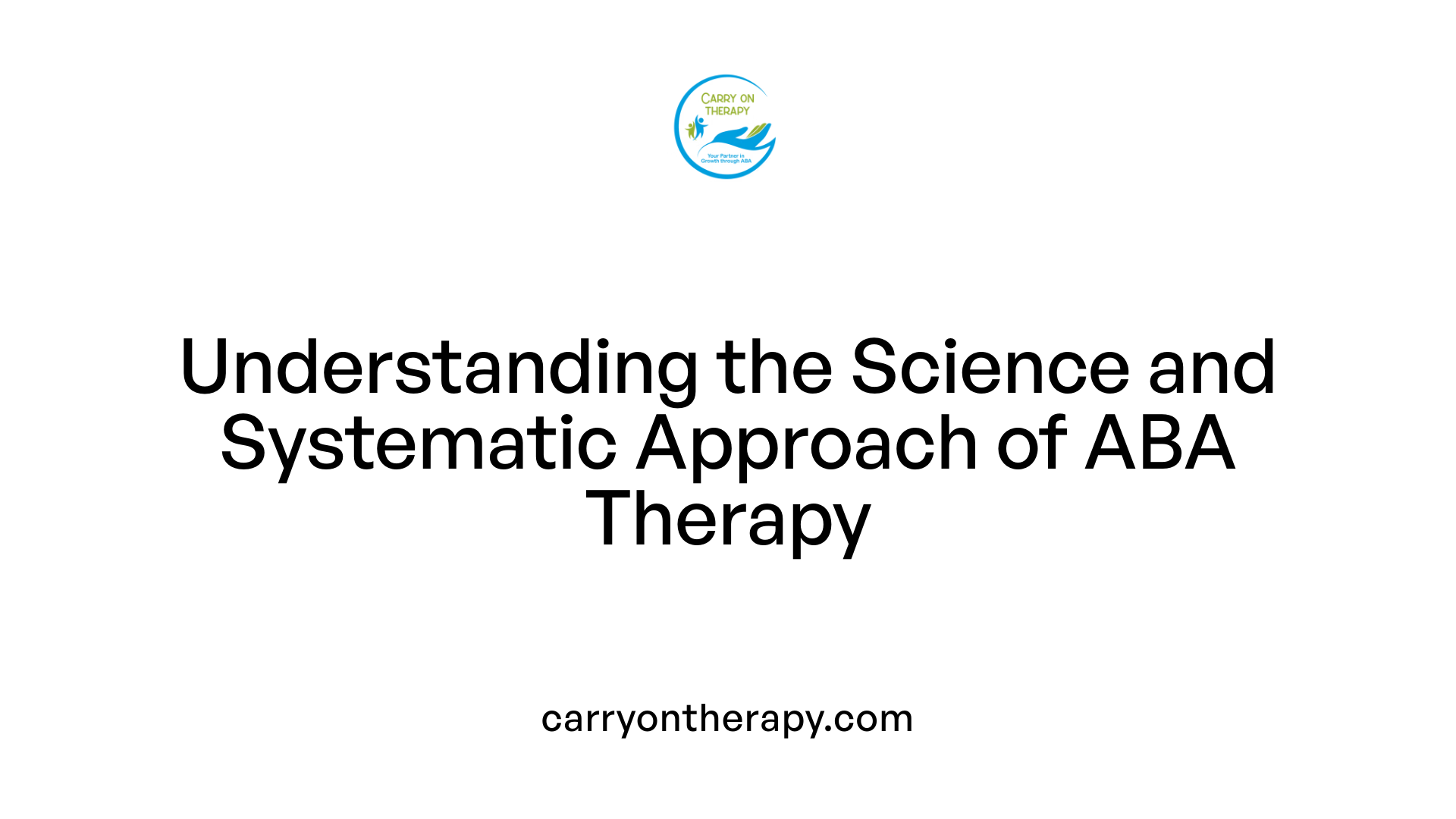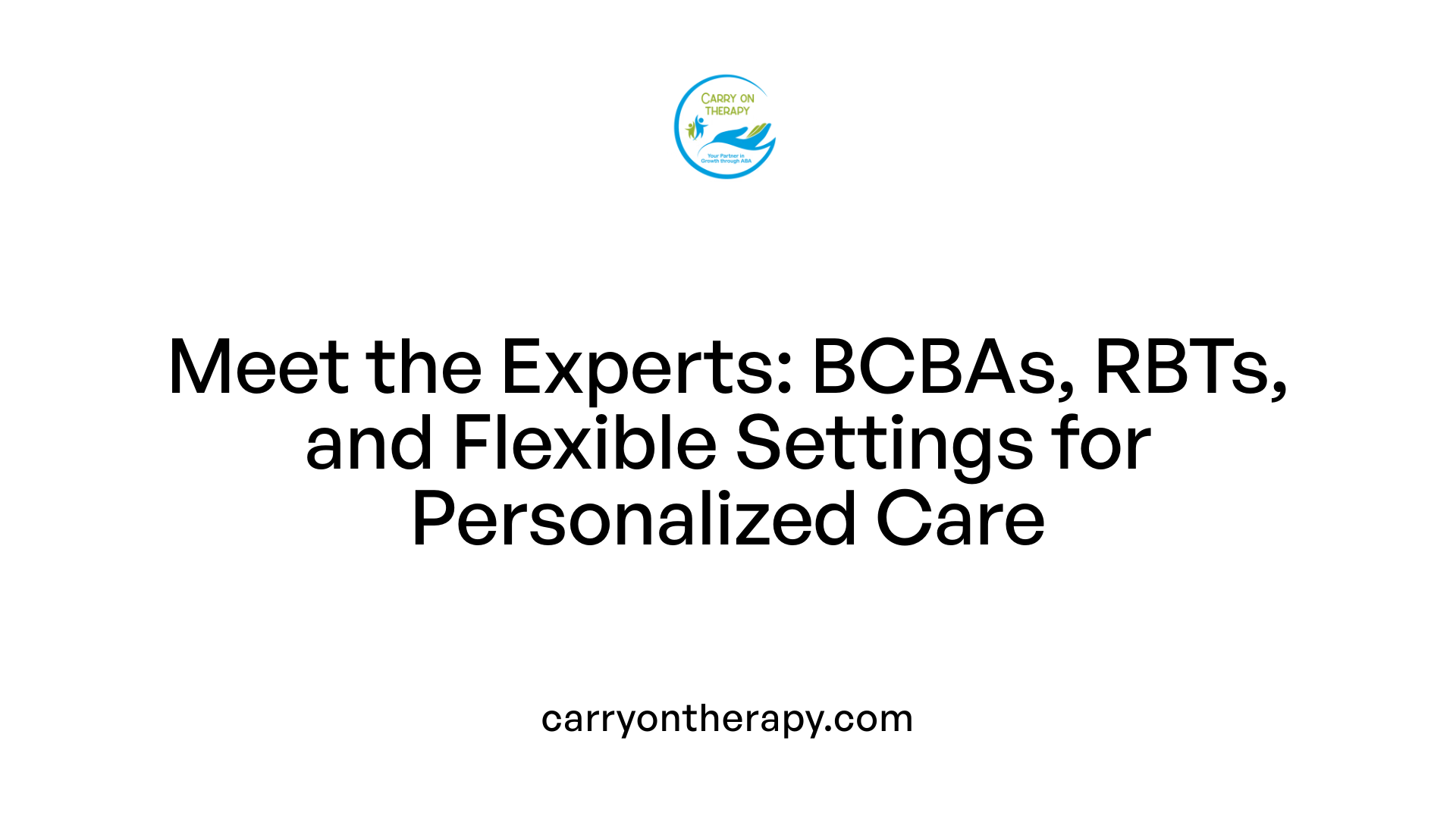ABA Therapy for Communication Challenges in Children
Harnessing ABA Therapy to Empower Kids with Communication Challenges

Understanding ABA Therapy and Its Role in Communication Development
Applied Behavior Analysis (ABA) therapy is a scientifically grounded approach designed to enhance communication abilities and address behavioral challenges in children with autism spectrum disorder (ASD). By breaking down complex behaviors into manageable steps and using positive reinforcement, ABA therapy facilitates meaningful improvements in communication and related skills. This article explores how ABA works, the role of professionals in its delivery, core therapy goals, and its proven effectiveness in supporting children facing communication difficulties.
What Is ABA Therapy? Foundations and Core Principles

What is Applied Behavior Analysis (ABA) therapy?
Applied Behavior Analysis (ABA) is a science-based therapy focusing on understanding how behavior is influenced by environmental factors. It uses this knowledge to increase helpful behaviors and reduce harmful or hindering ones. ABA is a widely recognized evidence-based intervention primarily used for children with autism spectrum disorder (ASD).
How does ABA focus on behavior and the environment?
ABA studies the relationship between behavior and the environment, emphasizing how changes in surroundings can alter behavior patterns. Therapists analyze antecedents (events before a behavior), the behavior itself, and consequences (events after the behavior) — known as the ABC model — to understand and shape behaviors effectively.
What techniques are used in ABA?
Key techniques include positive reinforcement, where desirable behaviors are rewarded to encourage repetition, and breaking complex skills into smaller, manageable steps. The ABC model helps therapists identify patterns and triggers, allowing targeted interventions. Other techniques like prompting and shaping support skill acquisition.
How are ABA treatment plans individualized?
Each ABA program is tailored to the individual’s unique needs by licensed professionals called Board Certified Behavior Analysts (BCBAs). They conduct thorough assessments to create specific goals spanning communication, social skills, self-care, play, motor, and academic abilities. The plans are continuously adjusted based on the individual’s progress tracked through data collection.
What evidence supports ABA as an autism intervention?
ABA is endorsed by authorities such as the US Surgeon General and the American Psychological Association as a best practice for autism treatment. Research shows intensive, long-term ABA therapy significantly improves intellectual functioning, language, social skills, daily living, and reduces challenging behaviors—especially when started early. This strong scientific backing makes ABA the current gold standard for autism interventions.
| Aspect | Description | Importance |
|---|---|---|
| Scientific Basis | Rooted in learning theory and behavior analysis | Ensures methods are evidence-supported |
| Behavior-Environment Link | Uses ABC model (Antecedent, Behavior, Consequence) to analyze and modify behavior | Allows precise, effective interventions |
| Techniques Used | Positive reinforcement, shaping, discrete trial training, and essential teaching strategies | Promotes skill acquisition and behavior change |
| Individualization | Programs designed by BCBAs to meet specific needs, continuously monitored and adjusted | Enhances efficacy and relevance |
| Evidence and Endorsements | Supported by decades of research and federal health authorities | Validates ABA as a trusted autism therapy |
This scientific, systematic approach makes ABA a powerful tool to support individuals with autism in leading more independent and fulfilling lives.
Who Provides ABA Therapy and How Is It Delivered?

Role of Board Certified Behavior Analysts (BCBAs)
ABA therapy is overseen by Board Certified Behavior Analysts, or BCBAs, who play a central role in designing and supervising personalized treatment plans. They conduct comprehensive behavioral assessments to understand the individual's needs before creating targeted intervention strategies to enhance communication, social skills, and independence while addressing challenging behaviors.
Supervision and Assessment for Personalized Plans
The process starts with thorough assessment by the BCBA to tailor the therapy program to the individual’s specific strengths and challenges. Continuous supervision throughout the therapy ensures that interventions remain effective and are adjusted as progress is tracked through detailed data collection.
Delivery Settings Including Home, Clinics, Schools, Telehealth
ABA therapy is flexible in its delivery. It can take place in various environments such as the client’s home, specialized clinics, schools, or remotely via telehealth platforms. This adaptability allows therapy to be accessible and integrated into daily routines and natural settings, promoting generalization of learned skills.
Use of Registered Behavior Technicians (RBTs)
Registered Behavior Technicians assist the BCBAs by implementing the therapy sessions. These trained technicians follow the intervention plans and apply ABA techniques under BCBA supervision, providing much of the direct interaction with the client during sessions.
Accredited Providers and Importance of Quality Standards
ABA services are often offered by organizations accredited by entities like the Behavior Analysis Certification Organization (BHCOE). Accreditation ensures adherence to rigorous clinical and ethical standards, providing families with confidence in the quality and safety of the therapy delivered.
How is ABA therapy typically delivered and who provides it?
ABA therapy is delivered primarily by registered technicians under the guidance of BCBAs who formulate and supervise individual plans. Accredited providers, operating in multiple settings such as homes, clinics, schools, or via telehealth, deliver these services. This team-based, flexible approach ensures personalized, evidence-based care that supports skill development and behavioral improvements in children and adults with autism spectrum disorder.
Primary Goals of ABA Therapy for Children with Autism
What are the goals of ABA therapy for individuals with autism?
ABA therapy is designed with the purpose of increasing helpful, functional, and socially meaningful behaviors. It focuses on building vital skills such as communication, language, and social interactions, which are often areas of challenge for children with autism.
Improvement of communication and social skills
One of the foremost goals of ABA is to enhance communication abilities, empowering children to express their needs, desires, and feelings more effectively. This includes developing verbal and non-verbal language, as well as social skills like turn-taking, eye contact, and appropriate peer interactions.
Reduction of problematic behaviors
ABA therapy employs positive reinforcement and systematic behavior analysis to reduce behaviors that hinder learning or daily life, such as aggression, tantrums, or self-injury. By teaching replacement behaviors and understanding environmental triggers, these challenges can be minimized.
Enhancement of self-care, academic and motor skills
Beyond communication, ABA supports teaching essential daily living skills such as dressing, eating, toileting, and hygiene. It also targets academic readiness and motor skill development, helping children become more independent and successful in school and everyday environments.
Promoting skill generalization and maintenance
ABA emphasizes consistency and reinforcement across different settings—home, school, and community—to ensure newly learned skills are retained and applied broadly. This approach helps children use their abilities functionally in real life.
Supporting independence and quality of life
Ultimately, ABA therapy aims to provide children with autism the tools they need to live more independently. By improving multiple domains of functioning, it fosters better social inclusion, academic progress, and family relationships, contributing to a higher quality of life.
| Goal Area | Description | Methods Employed |
|---|---|---|
| Communication & Social Skills | Enhancing language use and social engagement | Positive reinforcement, modeling, peer interaction |
| Problem Behavior Reduction | Minimizing disruptive or harmful behaviors by teaching alternatives | Behavior analysis, replacement behaviors |
| Self-care & Motor Skills | Teaching daily living and motor coordination | Task breakdown, chaining, reinforcement |
| Skill Generalization | Ensuring skills are maintained and transferred across environments | Consistency, practice in multiple settings |
| Independence & Quality of Life | Empowering functional independence and overall well-being | Individualized planning, family involvement |
Techniques Employed in ABA to Enhance Communication Skills

How does positive reinforcement encourage communication?
Positive reinforcement is central to ABA therapy, used to motivate children to practice and develop communication skills. Through rewards such as verbal praise, stickers, or tokens, children are encouraged to repeat desired behaviors, making communication efforts more frequent and effective.
How are skills broken into smaller, manageable steps?
ABA breaks complex communication skills into smaller, concrete steps to simplify learning. This step-by-step approach allows children to master foundational elements before progressing, which builds confidence and promotes sustained skill acquisition.
What roles do Discrete Trial Training and naturalistic teaching play?
Discrete Trial Training (DTT) is a structured technique that teaches communication through repeated, clear teaching trials, reinforcing correct responses immediately. In contrast, naturalistic teaching methods, like Pivotal Response Treatment, promote communication skills during typical activities and play, fostering more spontaneous and generalizable communication.
How do prompting, modeling, imitation, shaping, and chaining support skill development?
- Prompting guides the child toward the correct response, gradually faded as independence grows.
- Modeling involves demonstrating communication behaviors for the child to imitate.
- Imitation encourages the child to replicate speech or gestures.
- Shaping rewards successive approximations toward the desired communication behavior.
- Chaining breaks a complex communication sequence into smaller parts taught in order, helping build fluency.
How are Augmentative and Alternative Communication (AAC) tools used?
ABA incorporates AAC systems like Picture Exchange Communication System (PECS) and speech-generating devices to assist non-verbal children in expressing their needs and engaging socially. These tools complement verbal skills and provide additional communication avenues.
By combining these evidence-based techniques, ABA therapy effectively cultivates communication skills in children with autism, enhancing their ability to connect, learn, and engage with others.
Verbal Behavior Therapy (VBT) and Language Development in ABA
What is Verbal Behavior Therapy (VBT) within ABA?
Verbal Behavior Therapy (VBT) is a specialized subset of Applied Behavior Analysis focused on understanding and teaching language based on behaviorist principles. It categorizes different types of language functions, offering a structured approach to developing communication skills in children with autism.
How does VBT categorize language functions?
VBT breaks down language into operants that describe different communication actions:
- Mands: Requests or asking for wants and needs.
- Tacts: Labeling or commenting on objects, actions, or events.
- Echoics: Imitations of sounds or words heard.
- Intraverbals: Responses or answering questions.
- Autoclitics: Modifiers that clarify or change the meaning of language.
How does VBT aid in developing functional language skills?
By focusing on these operants, VBT helps children develop practical communication skills. For example, encouraging mands allows children to express their needs effectively. Teaching tacts supports labeling their surroundings, which builds vocabulary. Echoics improve verbal imitation, crucial for language learning. Intraverbals foster conversational exchanges, and autoclitics help refine language use.
How is verbal communication supported through VBT alongside other interventions?
VBT integrates with additional ABA strategies such as prompting, modeling, and reinforcement. It also complements tools like Augmentative and Alternative Communication (AAC), including Picture Exchange Communication System (PECS) and speech-generating devices, especially for non-verbal children. Structured methods like Discrete Trial Training and naturalistic approaches further support language acquisition.
Through VBT, children engage in targeted exercises that build a foundation for effective verbal communication, boosting social interactions and independence.
Augmentative Communication and ABA: Tools for Non-Verbal Children
What is PECS and how is it used in ABA?
The Picture Exchange Communication System (PECS) is a popular augmentative communication tool used within ABA therapy to help non-verbal children express their needs and thoughts. It involves using picture cards that the child can exchange with a communication partner to make requests or convey ideas. This visual system supports children in developing functional communication skills by breaking down language into manageable steps.
How do speech-generating devices support communication?
Speech-generating devices (SGDs) are electronic tools that produce spoken words or phrases when activated by the user, facilitating expressive communication for those who have limited or no speech. Incorporating SGDs into ABA therapy enables children to participate more fully in social interactions, enhancing both expressive and receptive communication abilities.
How are communication aids tailored to individual needs?
ABA therapy emphasizes individualized treatment plans designed by certified behavior analysts (BCBAs). Communication aids such as PECS or SGDs are selected and customized based on comprehensive assessments of the child's unique preferences, abilities, and goals. This tailored approach ensures the communication system aligns with the child's learning style and developmental stage.
How is AAC integrated within ABA therapy sessions?
In ABA sessions, AAC tools are systematically incorporated using methods like prompting, modeling, and reinforcement to encourage use of communication devices. Therapists teach children to use the tools during meaningful interactions, whether structured discrete trial training or natural environment teaching, to generalize skills across settings.
How does augmentative communication enhance expressive and receptive communication?
AAC methods like PECS and SGDs significantly improve expressive communication by providing alternative ways to initiate requests or respond. They also support receptive communication by helping children understand language through visual or auditory cues. This dual enhancement leads to better social interactions, reduced frustration, and higher independence.
These augmentative communication strategies embedded in ABA therapy create a supportive environment where non-verbal children can develop vital communication skills, fostering greater engagement and learning outcomes.
Measuring Progress and Adapting ABA Programs

How is progress in ABA therapy measured during sessions?
ABA therapy relies heavily on systematic data collection throughout therapy sessions. Therapists record observable behaviors and skill acquisition, quantifying improvements and challenges with precise measurements. This real-time data allows the therapy team to monitor how well the individual responds to specific interventions and identify which techniques are most effective.
How are ABA programs adjusted based on ongoing assessments?
ABA programs are not static; they require frequent evaluation and modification. Based on the collected data, therapists and Board Certified Behavior Analysts (BCBAs) make informed adjustments to treatment plans. This might involve changing goals, modifying teaching strategies, or introducing new targets to ensure consistent progress and address emerging needs.
What role do BCBAs play in monitoring and revising treatments?
BCBAs are central to overseeing ABA therapy. They conduct comprehensive assessments at the start and continuously throughout treatment. Using detailed data, they supervise and modify therapy to tailor interventions precisely to individual needs. Their expertise ensures that therapy remains evidence-based, goal-oriented, and aligned with best practices.
Why is individualized and flexible programming important in ABA?
Individualization allows ABA therapy to focus on the unique strengths, challenges, and preferences of each person. Flexibility in programming ensures that as individuals develop new abilities or encounter obstacles, their treatment evolves accordingly. This approach maximizes effectiveness by promoting engagement and relevance.
How does ABA ensure skill generalization and maintenance?
A major goal of ABA is for individuals to apply learned skills across various settings — home, school, community — and maintain them over time. Therapists incorporate strategies like practice in natural environments, involving family members, and reinforcing skills across contexts to support this generalization and long-term retention.
| Topic | Description | Impact on Therapy |
|---|---|---|
| Data Collection | Systematic recording of behaviors and skills during sessions | Enables objective monitoring |
| Ongoing Assessment | Regular review and interpretation of data to guide therapy decisions | Keeps treatment relevant and effective |
| BCBA Oversight | Expert supervision and adaptive treatment plan revisions | Ensures fidelity and quality of care |
| Individualized Programming | Tailors goals and techniques to person-specific needs | Enhances engagement and results |
| Skill Generalization | Practice and reinforcement across multiple environments | Promotes functional independence and real-life application |
Benefits of ABA Therapy on Communication and Social Interaction

Improved social interactions and peer engagement
ABA therapy significantly enhances social skills such as turn-taking, maintaining eye contact, and following instructions. Techniques like peer-mediated interventions actively involve typical peers to model social and communication skills, facilitating more natural interactions for children with autism. These improvements foster better integration in social settings and encourage positive peer relationships.
Reduced challenging behaviors through communication gains
As communication skills develop, problematic behaviors such as aggression, tantrums, and non-compliance often decrease. ABA focuses on teaching replacement behaviors and modifying antecedents to reduce triggers of challenging behaviors. Positive reinforcement encourages children to use newly acquired communication skills, helping them express needs and emotions appropriately.
Increased independence and academic readiness
ABA therapy teaches vital daily living skills including dressing, hygiene, and eating through a systematic breakdown of tasks and positive rewards. It also promotes academic readiness by improving attention, task-following, and transition management, supporting children's success in school environments.
Enhanced family relationships and self-esteem
Family involvement in ABA therapy strengthens communication within the household and promotes consistent application of learned strategies. This collaboration reduces parental stress and improves familial bonds. Additionally, as children gain autonomy and social competence, their self-esteem and confidence grow.
Long-term advantages starting with early intervention
Beginning ABA therapy early, ideally between ages 2 and 6, leads to more significant developmental gains in communication and social domains. Early intervention supports emotional regulation and independence, laying a foundation for improved lifelong outcomes and better integration into mainstream environments.
Family Involvement: A Crucial Component of ABA Success
How Does Parental Training and Collaboration with Therapists Enhance ABA Therapy?
Family involvement begins with direct training and collaboration between parents and BCBA-certified therapists. Parents learn specific ABA strategies and techniques tailored to their child’s needs, allowing them to implement consistent approaches outside therapy sessions. This collaboration fosters a unified intervention plan, strengthening the child’s progress across multiple environments.
Why is Reinforcing Skills at Home Vital in ABA?
Consistent reinforcement at home supports generalization of skills learned during therapy. Parents use positive reinforcement, prompting, and modeling to encourage communication, social skills, and daily living activities. This ongoing practice solidifies behavioral gains and helps children apply these skills in real-life situations beyond clinical settings.
How Does ABA Family Involvement Help Reduce Stress?
Improved communication within the family, as children develop functional language and reduced challenging behaviors, naturally lowers caregiver stress. When parents understand effective behavior management strategies and witness progress, their confidence and family dynamics improve, making home environments more supportive and less stressful.
What Visual Supports and Modeling are Used Within the Family?
Families often employ visual supports such as picture cards, visual schedules, and PECS systems to aid children's understanding and expression. Modeling desired behaviors through role-playing and structured social interactions at home further enhances learning, providing children with accessible examples of appropriate communication and social skills.
How Can Families Create Communication Opportunities Beyond Therapy?
Parents are encouraged to create diverse chances for communication during daily routines—such as meal times, play, or errands. Using joint attention techniques and prompting children to initiate interactions helps generalize communication skills, fostering increased independence and social inclusion.
Together, these family-centered approaches ensure ABA therapy extends beyond clinic walls, promoting meaningful and lasting developmental progress for children with autism.
Accessing ABA Therapy: Insurance, Providers, and Early Intervention Importance
Navigating Healthcare Provider Consultations
Accessing ABA therapy often begins with consulting healthcare providers who can offer referrals and initial guidance. These professionals help determine the child's needs and recommend ABA as a medically necessary treatment if appropriate, which is crucial for insurance approval.
Insurance Coverage: Private and Medicaid
ABA therapy is sometimes covered by private insurance plans and Medicaid when documented as medically necessary. Coverage details vary, so verifying benefits with the insurer early on can help families understand the extent of financial support available for intensive ABA programs.
Using Provider Resource Guides
Families and caregivers can find ABA providers through resource guides and local autism support organizations. These tools list licensed providers including board-certified behavior analysts (BCBAs), helping families locate qualified professionals tailored to their child’s needs.
Evaluating Providers Based on Qualifications and Protocols
Selecting the right ABA provider involves evaluating the team’s credentials, training, safety protocols, session structure, and goal-setting methods. Working with certified BCBAs ensures that treatment plans are individualized, evidence-based, and consistently monitored through data collection.
Emphasizing Early Start for Optimal Results
Research emphasizes starting ABA therapy early—ideally between ages 2 and 6—to maximize developmental gains, especially in communication and social skills. Early intervention can significantly improve long-term outcomes and increase independence, making timely access to quality ABA therapy critical for children with autism spectrum disorder.
The Transformative Impact of ABA Therapy on Communication Challenges
ABA therapy represents a scientifically supported approach that effectively addresses communication challenges in children with autism spectrum disorder by fostering critical skills through personalized, evidence-based interventions. Delivered under the guidance of trained professionals, it utilizes reinforced learning strategies and data-driven adaptations to enhance communication, socialization, and independence. Early and consistent intervention, combined with active family involvement, significantly amplifies therapy benefits, leading to improved quality of life and integration. As research continues to validate ABA's efficacy, families and practitioners are empowered with a robust toolset to support children in overcoming communication barriers and achieving their full potential.
References
- Applied Behavior Analysis (ABA)
- 5 Benefits of ABA Therapy for Autistic Child
- How ABA Therapy Can Improve Communication Skills in ...
- Benefits of ABA Therapy for Children with Autism
- How ABA Therapy Can Help Children with Behavioral ...
- How ABA Therapy Can Improve Your Child's Life
- Applied Behavior Analysis in Children and Youth with Autism ...





